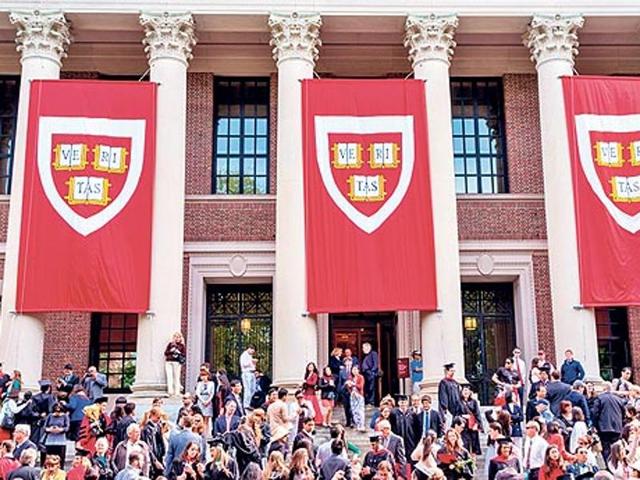Trump's Impact On Higher Education: Examining The Fallout Beyond Ivy League Institutions

Table of Contents
Shifting Funding Priorities and Their Impact on Non-Ivy League Institutions
The Trump administration's policies significantly altered the funding landscape for higher education, with profound consequences for institutions outside the Ivy League. These institutions, often already facing budgetary constraints, experienced the effects most acutely.
Decreased Federal Funding for Research and Grants
Budget cuts implemented during this period dramatically reduced federal funding for research and grants. This had a cascading impact on universities and colleges across the nation.
- Specific programs affected: The National Institutes of Health (NIH), the National Science Foundation (NSF), and numerous other grant programs experienced significant funding reductions.
- Consequences for faculty and students: Fewer research opportunities resulted in decreased faculty hiring, reduced research output, and a less competitive environment for attracting top students. This scarcity also led to increased pressure on remaining faculty and increased tuition costs to compensate for lost funding.
- Disproportionate impact: Smaller colleges and under-resourced universities, particularly those serving minority and low-income populations, felt the impact most severely, exacerbating existing inequalities in access to research and educational resources. These institutions often rely heavily on federal funding for their operational budgets and research initiatives.
Changes in Student Loan Programs
Changes to student loan programs further complicated the financial landscape for higher education. While some modifications aimed to simplify repayment, others impacted access to higher education, particularly at non-elite colleges.
- Changes in repayment plans: While some changes simplified repayment for certain borrowers, others introduced stricter eligibility criteria and reduced the availability of income-driven repayment plans, potentially increasing the burden of student debt.
- Impact on student debt levels: The already considerable issue of student loan debt was further exacerbated, impacting enrollment rates and post-graduation prospects for students at all levels of institutions, but especially impacting those at less affluent institutions whose graduates may have fewer high-paying job opportunities.
- Effect on enrollment rates: The increase in student debt and the uncertainty surrounding repayment plans may have discouraged some students from pursuing higher education, particularly those attending non-elite colleges where financial aid packages were less robust.
The Rise of Political Polarization and Its Influence on Curricula and Campus Climate
The Trump administration's presidency fueled political polarization, creating a turbulent environment for higher education institutions, particularly those outside the Ivy League. This polarization manifested in various ways, affecting curricula, campus climate, and the overall academic experience.
Increased Scrutiny of Higher Education's Political Leanings
Universities across the country faced increased scrutiny regarding their political leanings, particularly concerning issues of free speech, diversity initiatives, and curriculum content.
- Examples of specific controversies: Debates surrounding the inclusion of certain perspectives in curricula, restrictions on conservative speakers on campus, and the perceived politicization of diversity initiatives ignited heated public discourse.
- Impact on academic freedom: The pressure to conform to specific political viewpoints threatened academic freedom, creating a chilling effect on open inquiry and intellectual exploration, potentially limiting the freedom of professors to explore controversial or politically charged topics.
- Effects on faculty hiring and teaching practices: The political climate influenced hiring decisions, with some institutions potentially favoring candidates who aligned with specific ideological positions. Teaching practices were also subtly affected as professors adapted to a more politically charged environment.
Changes in Immigration Policies and their Effect on International Students
Changes in immigration policies and visa restrictions under the Trump administration profoundly impacted international student enrollment at non-Ivy League institutions.
- Specific policy changes: Restrictions on visas for international students, increased scrutiny of immigration applications, and a general anti-immigrant sentiment created an atmosphere of uncertainty and fear.
- Impact on university diversity: The decline in international student enrollment diminished campus diversity and the richness of the educational experience, making the campus less diverse and potentially impacting the internationalization of the curriculum.
- Economic consequences: Many colleges and universities rely on tuition revenue from international students. The decrease in international enrollment negatively affected the financial stability of these institutions, particularly those located in regions less attractive to international students.
Long-Term Consequences and the Future of Higher Education beyond the Elite
The Trump administration's policies have left a lasting impact on higher education, creating long-term consequences for access, affordability, and the overall landscape of the educational system.
The Widening Gap in Access and Affordability
Trump-era policies have exacerbated existing inequalities in access to and affordability of higher education, particularly impacting institutions beyond the Ivy League.
- Potential long-term effects on social mobility: Reduced access to higher education for students from low-income backgrounds and marginalized communities hinders social mobility, perpetuating existing inequalities.
- The future of regional colleges and universities: Many regional colleges and universities, already struggling with financial constraints, face an uncertain future, potentially leading to closures or mergers.
- Potential for increased inequality: The disparities in access and affordability are likely to widen, creating a more stratified system where access to quality higher education becomes increasingly linked to socioeconomic status.
Adapting to a Changing Landscape
Colleges and universities outside the Ivy League must adapt to the evolving political and financial landscape. This requires innovative strategies and proactive approaches.
- Examples of innovative funding models: Exploring new sources of revenue, such as partnerships with industry, philanthropic initiatives, and alternative tuition models.
- Strategies to enhance affordability: Implementing measures to reduce tuition costs, such as increasing financial aid and scholarships, and exploring innovative approaches to cost-cutting.
- Methods of promoting diversity and inclusion: Developing targeted recruitment strategies to attract a diverse student body and fostering an inclusive campus climate.
Conclusion
The Trump administration's policies significantly impacted higher education, creating a ripple effect felt far beyond the hallowed halls of Ivy League institutions. The multifaceted consequences – financial, political, and social – have left a lasting legacy, exacerbating existing inequalities and challenging the future of higher education across the nation. Understanding Trump's impact on higher education requires a comprehensive analysis of funding changes, the politicization of campuses, and their effects on access and affordability. To ensure equitable access to higher education for all, we must actively engage with these issues, research specific policy changes, support organizations working to improve access, and advocate for policies that prioritize affordability and inclusivity. Analyzing the effects of Trump's policies on higher education is crucial for shaping a more just and equitable future for all students.

Featured Posts
-
 Analyzing The 2000 Yankees Joe Torres Impact And Andy Pettittes Shutout Performance
Apr 28, 2025
Analyzing The 2000 Yankees Joe Torres Impact And Andy Pettittes Shutout Performance
Apr 28, 2025 -
 Could Espns 2025 Red Sox Outfield Prediction Come True
Apr 28, 2025
Could Espns 2025 Red Sox Outfield Prediction Come True
Apr 28, 2025 -
 Alberta Economy Hit By Dow Project Delay Tariff Fallout
Apr 28, 2025
Alberta Economy Hit By Dow Project Delay Tariff Fallout
Apr 28, 2025 -
 Could Aaron Judge Join Team Usa For The 2026 World Baseball Classic
Apr 28, 2025
Could Aaron Judge Join Team Usa For The 2026 World Baseball Classic
Apr 28, 2025 -
 Mlb Red Sox Blue Jays Lineups Buehlers Start And Outfielder Comeback
Apr 28, 2025
Mlb Red Sox Blue Jays Lineups Buehlers Start And Outfielder Comeback
Apr 28, 2025
